Nigerian Finder

Queen Elizabeth’s Visit to Nigeria: History & Details
An important part of the history of Nigeria is her colonial story. Under colonialism and under the administration of Britain, the Queen (Queen Elizabeth) was the highest monarchical authority who was in control of government affairs. She carried out ceremonial functions in her position as head of state in the colonised Nigeria. She was also the monarch of the other common wealth realms, including the United Kingdom.
Even when Nigeria gained her independence in 1960, the Queen still held a high and important status in Nigeria. Queen Elizabeth was Queen of Nigeria from 1960-1963, the time between the nation’s independence and when she became a republic. You can see now the reasons her visits to Nigeria were always with such great fuss.
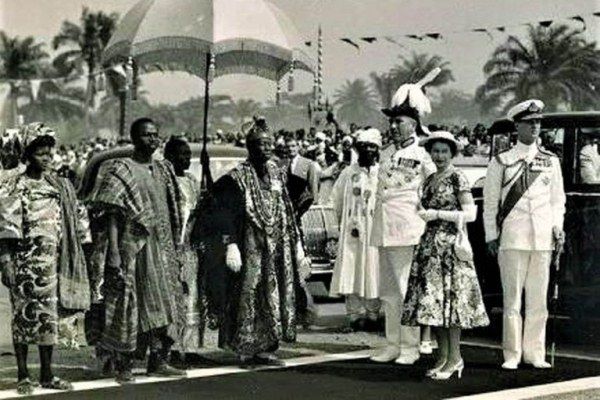
During her reign as head of state and Queen of Nigeria, Queen Elizabeth visited Nigeria twice.
The first time was in 1956, from the 28 th of January to the 16 th of February, 1956. At the airport, she was welcomed by federal dignitaries which included the Minister for Labour and Welfare at the time, Festus Okotie-Eboh and Governor-General Sir James Robertson. She was driven around in a Rolls Royce in the country’s capital, Lagos with lots of fun fare and royal services. She spent time in the Northern part of the country with the Sultan where she visited Kano and Kaduna. She also visited Jos and Enugu. The second time was when she attended the Common wealth Heads of Government meeting which was held between the 3 rd to the 6 th of December, 2003.
The 2003 Commonwealth Heads of Government Meeting was the eighteenth meeting of the Heads of Government of the Commonwealth of Nations. It was held in Abuja, Nigeria and hosted by the then President, Olusegun Obasanjo.
During the meeting, the Zimbabwean issue was dominant. This was the dispute over Zimbabwe’s suspension which led to another dispute over the re-election of Secretary-General Don McKinnon. Before the end of the meeting, Robert Mugabe’s announced that Zimbabwe was withdrawing from the Commonwealth. This best explains the need for the presence of the Queen at the meeting. In a letter addressed towards the Nigerian President at the time, the Queen explained that her visit was a demonstration of the value Britain attached to its relations with Nigeria and recognition of the country’s role on the international stage. Queen Elizabeth opened the Commonwealth Heads of Government Meeting in Abuja on Friday, 5th December. Herself and the Duke of Edinburgh (often referred to as Her Majesty and His Royal Highness respectively) also attended other events during the Meeting.
During the Queen’s first visit in 1956, she went on a tour, known as the Queen’s 1956 Tour of Nigeria and the following incidents took place
Queen Arrives In Lagos (1956)
Queen Elizabeth and Prince Philip received welcome in the Nigerian capital, Lagos at the very start of the Royal tour
Inauguration Of New Federal Courts (1956)
The Queen attended the inauguration of the new federal courts in Nigeria.
The Queen was at the Durbar also known as the Royal Durbar (1956)
At Kaduna, the then capital of Northern Nigeria, Queen attended a Royal Durbar
The Queen visited Kano (1956)
Queen elizabeth and duke philip visited jos – tin mines (1956).
Nigerian tribal canoes held a regatta for the Queen at Port Harcourt on the Ronny River after which she visited a Leper colony
Queen went on a tour in Enugu, Nigeria (1956)
When on the Royal tour, The Queen went on a visit to children’s rally and a tribal dancing at Enugu, Nigeria.
In Lagos, Queen Elizabeth attended a garden party and a formal session of the Federation Parliament.
The life of Queen Elizabeth
Queen Elizabeth became queen following her father’s death in 1952. She was 25 years old at the time and became the queen regent of seven independent Commonwealth countries which were the United Kingdom, Canada, New Zealand, South Africa, Pakistan, and Ceylon (later renamed Sri Lanka). Many of the colonial realms, to include Nigeria gained independence during the course of her reign. As of the year, 2018, Queen Elizabeth II has been ruling England for 66years and is currently the longest-reigning British monarch in history
The role of Queen Elizabeth in colonial Nigeria
British influence in Nigeria began with the prohibition of the slave trade to British subjects in 1807. In 1861, Britain incorporated Lagos and in 1884, the Oil River Protectorate was established. It was at the Berlin’s conference of 1885 that other European powers acknowledged Britain’s dominance over the Niger area.
From 1886 to 1899, much of the Niger area was ruled by the Royal Niger Company, authorized by charter, and governed by George Taubman Goldie. On 1 January 1900, the Royal Niger Company transferred its territories to the British government for the sum of £865,000; the Southern Nigeria Protectorate and Northern Nigeria Protectorate were then passed from the Royal Niger Company to the Crown. The constitutions after the world war were progressive and allowed for increased representation and electoral government by Nigerians. The colonial period in Nigeria was precisely from 1900 to 1960, after which Nigeria gained its independence.
Queen Elizabeth II was Queen of Nigeria forms 1960- 1963: Nigeria was an independent constitutional monarchy . She was also the monarch of the other commonwealth nations such as the United Kingdom .
Nigeria became independent on 1 October 1960 by a British Act of Parliament. Nnamdi Azikiwe was installed as Governor-General of the federation and Tafawa Balewa continued to serve as head of a democratically elected parliamentary. The Queen was head of state in Nigeria, though her constitutional roles were mostly delegated to the Governor-General of Nigeria . The Governor-General represented the British monarch as head of state and was appointed by the Crown on the advice of the Nigerian prime minister in consultation with the premiers of the regions. The Governor-General was also responsible for appointing the prime minister and for choosing a candidate when there was no parliamentary majority. Other than this, the Governor-General’s office was essentially ceremonial.
The retention of the monarchy was not accepted by all and the political parties in Nigeria at the time agreed that the country should be a republic.
Nigeria adopted the President of Nigeria as head of state, on 1 October 1963 and hence, severed its relationship with the British monarchy.
1 thought on “Queen Elizabeth’s Visit to Nigeria: History & Details”
This article is okay but not telling us the full details,the queen also visited inevitably ode and some other few towns but it wasn’t mentions here and I don’t know why, anyway I got some information here too I haven’t gotten where I saw ither
Leave a Comment Cancel reply
You must be logged in to post a comment.
Global site navigation
- Celebrity biographies
- Messages - Wishes - Quotes
- TV-shows and movies
- Fashion and style
- Capital Market
- Celebrities
- Family and Relationships
Local editions
- Legit Nigeria News
- Legit Hausa News
- Legit Spanish News
- Legit French News
Queen Elizabeth: Two Times England's Monarch Has Visited Nigeria
- Queen Elizabeth II (96 years) has been to Nigeria only two times after she was crowned England's monarch in 1953
- The first time the then-young queen visited Nigeria was in 1956 three years after she ascended the throne
- After this, Queen Elizabeth was in the west African country in 2003 during the administration of former President Olusegun Obasanjo to attend the Commonwealth Heads of Government Meeting
PAY ATTENTION: You can save a live of girl at risk. Donate to Legit Charity on Patreon. Your support matters!
Queen Elizabeth who is currently under close medical supervision in Balmoral, United Kingdom (UK), on doctors' orders, has visited Nigeria only twice.
There is approximately a time frame of 53 years between both visits to Nigeria by the monarch.
Queen Elizabeth's 1st visit: 28 January - 16 February 1956
About three years after she was coronated as the monarch of England (1953), Queen Elizabeth toured parts of the British empire and the commonwealth, a feat her predecessors never achieved.
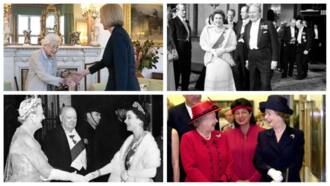
Full list: 15 prime ministers who served during Queen Elizabeth II's reign
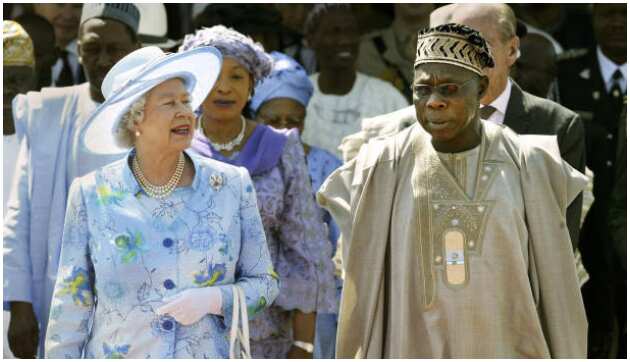
PAY ATTENTION: Subscribe to Digital Talk newsletter to receive must-know business stories and succeed BIG!
One of the destinations of her overseas visits was Nigeria (from 28 January to 16 February 1956).
At the time, Queen Elizabeth stopped off to inspect the soldiers of the Nigeria Regiment. In her honour, the force was renamed the Queen's Own Nigeria Regiment after the visit.
It is recorded that the queen was welcomed by federal dignitaries which included the Minister for Labour and Welfare at the time, Festus Okotie-Eboh, and Governor-General Sir James Robertson.
She was driven around in a Rolls Royce in Lagos amid fun fare and royal services.
Elizabeth was said to have spent more time in the Northern part of the country (Kano and Kaduna). But she also visited Jos and Enugu .
Queen Elizabeth's second visit to Nigeria: 3–6 December 2003
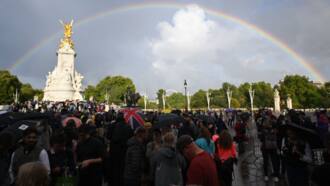
Hours before Queen's death, double rainbow appears at Buckingham Palace, many get emotional
The next the queen came to Nigeria was majorly for the 2003 Commonwealth Heads of Government Meeting held in Abuja where she was hosted by former President Olusegun Obasanjo .
The queen made it clear that her visit was in recognition of the value Britain attached to its relations with Nigeria as well as the country’s place in the global space.
She opened the Commonwealth Heads of Government Meeting in Abuja on Friday, 5th December. The Duke of Edinburgh was also in attendance.
Queen Elizabeth’s security breached after intruder disguised As priest manages to enter palace
An unidentified man landed himself in hot water after he disguised as a priest to enter Queen Elizabeth's, Windsor Castle.
According to reports, the man told security personnel at the royal residence that he was friends with the chaplain at the army barracks.
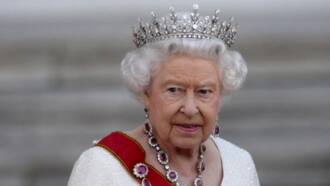
5 key changes bound to happen in United Kingdom following Queen Elizabeth II's death
Upon admission into the palace, the intruder was offered a bed and something to eat.
After enjoying his meal, he is reported to have had a chat with the royal guards telling them his life history.
Source: Legit.ng
Onyirioha Nnamdi Onyirioha Nnamdi is a graduate of Literature and English Language at the University of Lagos. He is a Politics/Current Affairs Editor who writes on news and political topics for Legit.ng. He brings into his reporting a wealth of experience in creative and analytical writing. Nnamdi has a major interest in local and global politics. He has a professional certificate from Reuters and was awarded the editor with the best listicle for 2021. Contact: 08062988054, [email protected]

- Switch skin
Queen Elizabeth’s First Visit to Nigeria in 1956 (with Video)
The Queen of England, Queen Elizabeth II, visited Nigeria for the first time on the 28th of January, 1956, four years to Nigeria’s independence and stayed for 20 days.
She was received with a military parade at the Ikeja Airport in Lagos and welcomed by dignitaries such as the then Governor-General, Sir James Robertson, his wife, the Minister of Labour ( Festus Okotie-Eboh ) and the Oba of Benin, Oba Akenzua II.

Nigerians, eager to see the Queen, stormed the streets of Lagos with banners and flags. Queen Elizabeth II and the Duke of Edinburgh were driven past the cheering crowds in an open car to the Municipal Boundary.
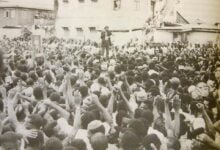
Queen Elizabeth II also met with the Oba of Lagos, Oba Adeniji-Adele II. Little Folashade Lawson, daughter of the Chairman of Lagos Town Council, presented Queen Elizabeth II a bouquet on her knees.
Before the Queen left on the 16th of February, 1956, she visited other parts of Nigeria such as Port Harcourt and Kaduna where she graced the Dubar festival.
Thanks for reading, OldNaija.com
Questions? Advert? Click here to mail us or click here to call us.
You Might Also Like
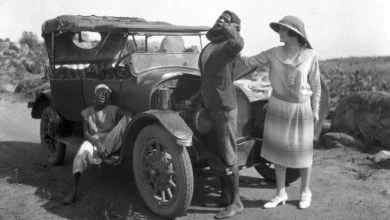
Palava: The First Film Shot in Nigeria, 1926
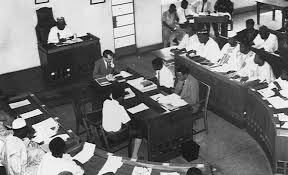
The Clifford Constitution of 1922 – Features, Merits & Demerits
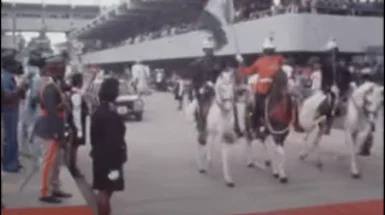
Watch the Video of Nigeria’s Independence Day Celebration in 1978
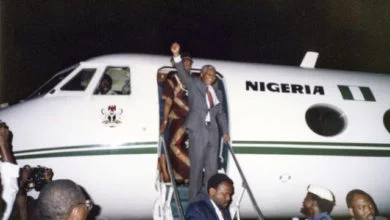

Video: Nelson Mandela’s Gratitude Visit to Nigeria in 1993
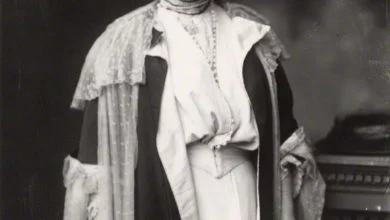
How and Why Flora Shaw, Lord Lugard’s Wife, Coined the name Nigeria in 1897
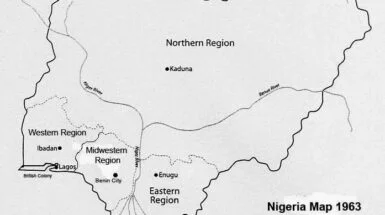
How Nigeria’s Mid-Western Region was Created in 1963
This site wows me. i just can’t leave it. so interesting. Can i add you up on fb please. would love to write for you. even if it’s free. just want to contribute.
Yes you can. Your contributions will be much appreciated. Thank you, Mr. Oty Emmanuel.
It is great to be here. This will rekindle my unrivaled love for history. i hope to write for you also.
It’s also great to have you here, Miss/Mrs Quincy Onuwaje. I’m glad to know you’re a history lover. I’ll be looking forward to working with you. Kindly contact me with the number on the sidebar. Cheers!
Leave a Reply Cancel reply
Your email address will not be published. Required fields are marked *

When Queen Elizabeth II Visited Nigeria

By Toyosi Onabanjo
Queen Elizabeth II’s death on 8 September has occasioned many tributes but also many Twitter jokes, some of them about the late Queen’s cherished Pembroke Welsh corgis. Being a former Queen of Nigeria, it is expected that Nigerians have an opinion about the monarch who passed away aged 96 at the Balmoral Castle in Scotland. Thus far, the reactions have been mixed—many have hailed the Queen, the gospel singer Tope Alabi going as far as making a montage in veneration; some others have tweeted less than salubrious remarks. But at least all can agree that the Queen is one of the most important people in world history.
Born Elizabeth Alexandra Mary on 21 April 1926, she ascended the British throne in 1952, following the death of her father and former king, George VII. At only twenty-five years old, she became the queen of seven independent Commonwealth countries: The United Kingdom, Australia, New Zealand, South Africa, Pakistan, and Ceylon (now Sri Lanka). She was Nigeria’s constitutional monarch from 1960 until 1 October 1963 when Nigeria became a republic.
At the time of succeeding her father, the British Empire was on the cusp of its demise and many former British colonies were clamoring for independence, with Ghana attaining it in 1957 and Somalia and Nigeria both attaining theirs in 1960.
Elizabeth was crowned in 1953, a year after her father’s passing. As queen, one of her ceremonial duties included visiting the British colonies, to which Nigeria belonged. She visited Nigeria twice—in 1956 when Nigeria was a British colony and in 2003 when Nigeria was already a sovereign nation.
First Visit
Queen Elizabeth’s visit to Nigeria in 1956 happened three years after ascending the British throne. She landed in Nigeria’s former capital, Lagos, along with her entourage, among whom was her late husband, Philip Mountbatten, the Duke of Edinburgh. She was received by thousands at the airport. In that number was the then Governor-General of Nigeria, James Robertson; Festus Okotie-Eboh; and the then-Oba of Lagos, Adenji-Adele II . A twenty-eight-year-old Elizabeth wore a pink floral dress, a brimmed hat, and a pair of white opera gloves to match a white handbag. She was a picture of youth and royalty.
She spent twenty days in Nigeria, from 28 January to 16 February. In her husband’s company, she toured the country, visiting Kano, Kaduna, Enugu, among others.
She worshipped at the Cathedral Church of Christ in Marina, Lagos, an Anglican church founded by Reverend Samuel Ajayi Crowther and which during the Queen’s visit was under the provost Reverend A.W. Howells. During her visit, the Queen donated a chair to the cathedral.
While in Nigeria, the Queen commissioned the Nigerian painter and sculptor Ben Enwonwu to make a bronze sculpture of herself. The next year, she posed in London as Enwonwu banged metal against his imagination in order to bring an outsized version of the Queen to life. The sculpture was completed in 1957, and in November of the same year was presented at the Royal Society of British Artists exhibition in London.
Second Visit
The second time Queen Elizabeth visited Nigeria, she was 76 years old. She retained the brimmed hat, but this time it nested wreaths of grey hair. The flower of youth had withered, but the royal grace endured.
This time the Queen visited Abuja and was hosted by then-President Olusegun Obasanjo. She was in the country to attend the Commonwealth Heads of Government meeting—the 18th of its kind—that had representatives from 51 Commonwealth countries in attendance. 3 Commonwealth nations were not in attendance—the suspended Zimbabwe and Pakistan who were not invited, and Antigua and Barbuda who were not suspended but sent no representative.
The meeting garnered great media attention at the time. Discussed in the meeting was Zimbabwe’s controversial suspension from the Commonwealth of Nations. There was also a dispute over the re-election of the New Zealander Don McKinnon as Secretary General.
The Queen was in Nigeria from December 3rd to December 6th.
In spite of the controversies that have tailed her public life and some negative remarks that have tailed her demise, the Queen leaves behind a rich legacy. Having reigned for 70 years and 214 days, Queen Elizabeth II was the longest-serving British monarch and the longest recorded of any female head of state. She was the second longest-reigning monarch in world history, only behind France’s Louis XXIV. Her death itself is symbolic. Having lived nearly a century, in which time she lived through major global political and cultural changes, her demise in many ways epitomizes the end of an era. Or two eras. Or three.
Queen Elizabeth II is succeeded by her eldest son, Charles III.
Toyosi Onabanjo is a freelance technical and entertainment writer who lives in Lagos.
Related Posts
- Saturday, June 29, 2024

© 2023 - Businessday NG. All Rights Reserved.
In Photos: The British Royal Family's Visits to Nigeria
As Prince Harry and Meghan Markle's trip to Nigeria is underway, look back on other royal visits by Queen Elizabeth, King Charles, and more.

Nigeria is former British colony; the country gained independence in 1960, but remains a member of the Commonwealth , a voluntary association of 56 countries. Following Queen Elizabeth's death in 2022, King Charles succeeded his mother as head of the organization. "It is my sincere wish that the Commonwealth will continue to offer stability and continuity for future generations and will decide that one day the Prince of Wales should carry on the important work started by my father in 1949," Queen Elizabeth said in 2018. During her reign, Queen Elizabeth visited Nigeria twice—in 1956, when Nigeria was still a colony, and 2003, for the Commonwealth Heads of Government Meeting. Thus far, King Charles has yet to visit in his capacity as head of the Commonwealth. He previously visited in 1990 with his then-wife, Princess Diana , and again in 1999, 2006, and 2018.
In chronological order, here are the best photos of British royals in Nigeria:

In 1956, Queen Elizabeth and Prince Phillip undertook a royal tour of Nigeria.

On their trip, they went to Lagos, Calabar, Enugu, Jos, Kaduna, Kano, and Port Harcourt. Here, the royal couple is pictured speaking with Cheif Okosoi at a reception at Enugu

At Kaduna Airport, Queen Elizabeth inspected a regiment.

The Queen met with Governor of the Western Region in Ijebu-ode.

In 1960, Nigeria declared independence, and Princess Alexandra traveled to the country to represent Queen Elizabeth at the independence celebrations. Here, she reads the Queen's speech in Lagos.

In 1990, Princess Diana and Prince Charles undertook a royal visit of Nigeria.

Diana and Charles each carried out a number of engagements solo.

See all the photos of Charles and Diana's trip to Nigeria here.

In 2001, the Princess Royal undertook a six-day royal visit to Nigeria.

In 2003, Queen Elizabeth and Prince Philip returned to Nigeria for the annual Commonwealth heads meeting.

Here, Queen Elizabeth meets Noidi Okereke Onyiwke (L, wearing purple), Director General of the Nigerian stock exchange, during a reception shortly after her arrival.

In this photo, Queen Elizabeth tours the secretariat of Karu Local council, near Abuja.

Philip and Elizabeth wave goodbye at the airport.

Then-Prince Charles set out on a royal tour of West Africa, and Nigeria was the second leg of his trip.

Here, Charles visited the oldest church in northern Nigeria located in Zazzau.

He returned 12 years later, with Camilla, then the Duchess of Cornwall.

See all the best photos of Charles and Camilla's 2018 tour of West Africa, here .

Prince Harry and Meghan Markle kicked off their three-day visit to Nigeria at a school.

Meghan took a selfie with students as Harry made a funny face behind them.
Emily Burack (she/her) is the Senior News Editor for Town & Country, where she covers entertainment, culture, the royals, and a range of other subjects. Before joining T&C, she was the deputy managing editor at Hey Alma , a Jewish culture site. Follow her @emburack on Twitter and Instagram .
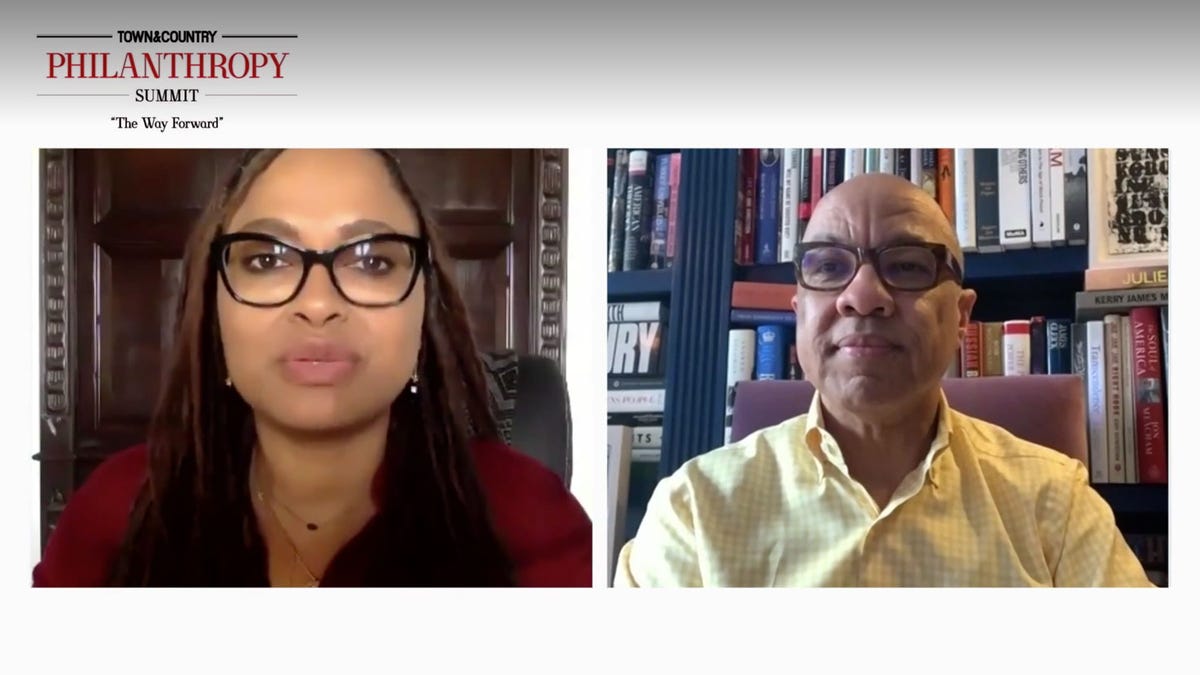
@media(min-width: 40.625rem){.css-1jdielu:before{margin:0.625rem 0.625rem 0;width:3.5rem;-webkit-filter:invert(17%) sepia(72%) saturate(710%) hue-rotate(181deg) brightness(97%) contrast(97%);filter:invert(17%) sepia(72%) saturate(710%) hue-rotate(181deg) brightness(97%) contrast(97%);height:1.5rem;content:'';display:inline-block;-webkit-transform:scale(-1, 1);-moz-transform:scale(-1, 1);-ms-transform:scale(-1, 1);transform:scale(-1, 1);background-repeat:no-repeat;}.loaded .css-1jdielu:before{background-image:url(/_assets/design-tokens/townandcountrymag/static/images/diamond-header-design-element.80fb60e.svg);}}@media(min-width: 64rem){.css-1jdielu:before{margin:0 0.625rem 0.25rem;}} Royal Family News @media(min-width: 40.625rem){.css-128xfoy:before{margin:0.625rem 0.625rem 0;width:3.5rem;-webkit-filter:invert(17%) sepia(72%) saturate(710%) hue-rotate(181deg) brightness(97%) contrast(97%);filter:invert(17%) sepia(72%) saturate(710%) hue-rotate(181deg) brightness(97%) contrast(97%);height:1.5rem;content:'';display:inline-block;background-repeat:no-repeat;}.loaded .css-128xfoy:before{background-image:url(/_assets/design-tokens/townandcountrymag/static/images/diamond-header-design-element.80fb60e.svg);}}@media(min-width: 64rem){.css-128xfoy:before{margin:0 0.625rem 0.25rem;}}

Prince Hussein & Princess Rajwa's Sweetest Photos

Princess Anne Discharged From Hospital

Who Is Princess Aiko?
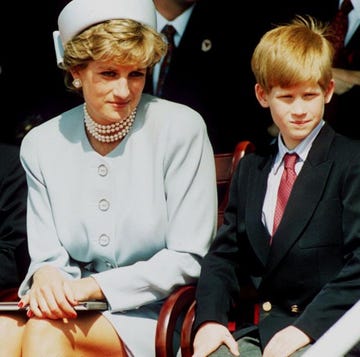
Prince Harry on Mourning Mom Diana’s Death

Wimbledon Organizers Hope Kate Will Attend

Prince Harry to Receive ESPY Award

Portrait Bust of Queen Elizabeth II to be Sold

Princess Margaret's Grandson at the State Banquet

Jason Kelce on Meeting Princess Charlotte

The Duchess of Edinburgh's Most Stylish Moments

Camilla's Royal Style Evolution
- Celebrities
- Beauty & Health
- Relationships & Weddings
- Food, Travel, Arts & Culture
- International
- Pulse Picks
- Celebrity Picks
- Pulse Influencer Awards
How many times did Queen Elizabeth visit Nigeria?
The Queen died yesterday Thursday, September 8th 2022 at the age of 96 and it is a good time to begin a throwback on the times she visited Nigeria.
The Queen (Queen Elizabeth II) was the monarchical authority who had the constitutional position as the Head of State of Nigeria from 1953-1963. She was officially called Queen of Nigeria
Recommended articles
Who is the queen.
The Queen is the ruler of the United Kingdom and the other commonwealth nations. During the British rule of Nigeria, Queen Elizabeth served as a monarch until the end of the Republic in 1963. She performed ceremonial duties in her capacity as the head of state of colonized Nigeria.
She visited Nigeria twice.
She came to Nigeria for the first time in 1956 as part of her royal tour to Commonwealth countries, from January 28 to February 16.
Her arrival was full of pomp and pageantry. Many dignitaries greeted her at the airport, including Sir James Robertson, the governor-general, and Festus Okotie-Eboh, the then-minister of Labour and Welfare and many heads of government and traditional leaders.
The former capital was Lagos state and that was where she landed. She was driven around in a Rolls Royce. She went on a royal tour of Lagos and many places other places. She also travelled to Northern Nigeria where she visited the Sultan of Sokoto. The Queen also went to Kano, Kaduna, Enugu and Jos.
The second time she visited Nigeria was during the Commonwealth Heads of Government Meeting, which took place from December third to sixth 2003.
The Commonwealth Heads of Government Meeting in 2003 was the 18th time the Commonwealth heads were met.
Olusegun Obasanjo , Nigeria's then-president, hosted the event in Abuja. She came with her husband the Duke of Edinburgh.
The conflict during the Commonwealth meeting was the crisis in Zimbabwe over Secretary-General Don McKinnon's re-election. Robert Mugabe declared that Zimbabwe was leaving the Commonwealth just before the gathering ended.
Even though many countries were declaring independence at the time she ascended the throne (1953), the Queen always expressed love for the Commonwealth countries.
JOIN OUR PULSE COMMUNITY!
Welcome to the Pulse Community! We will now be sending you a daily newsletter on news, entertainment and more. Also join us across all of our other channels - we love to be connected!
Eyewitness? Submit your stories now via social or:
Email: [email protected]
Ask Pulse: The woman of my dreams has friend-zoned me — how do I get out?
This week’s best celebrity pictures on instagram, why we broke up: he thinks his mother is a witch, tedxlagos sparks inspiring conversations about 'the future we see', it’s a 'jollof rice battle' in latest episode of cooking with gamechangers, 10 beer and food pairing experiences you should try this weekend, 10 normal things that are banned in north korea, what is micro-cheating 10 signs your partner is micro-cheating on social media, how to clean your washing machine for fresher, cleaner clothes, 50 empowering sigma quotes on strength, independence, and success, how to stop being lazy and get work done efficiently, best-dressed celebs at sharon ooja’s wedding, pulse sports, ‘afcon >>> euros’ — super falcons star reacts after watching boring england, transfer news live: latest done deals, updates in the premier league, la liga, serie a and more, african championships: ese brume wins nigeria's third gold as 400m sensations ogazi and joseph cop bronze medals, ‘i don't care who you are’ - afcon winner hits out at osimhen after social media rant about finidi.
Welcome to the Pulse Community! We will now be sending you a daily newsletter on news, entertainment and more. Also join us across all of our other channels - we love to be connected! Welcome to the Pulse Community! We will now be sending you a daily newsletter on news, entertainment and more. Also join us across all of our other channels - we love to be connected!
Pythons attack people on this island — there is no shortage of fatal cases
How those steeze images of Farooq Oreagba at Ojude Oba Festival came alive
New study reveals surprising effect of consuming garlic
- WikiLeaks co-founder Julian Assange: the story of a guilt plea in exchange for his freedom.
- Food Armageddon in Nigeria: The Role of Fulani Herders in the Destruction of Farmlands and Communities (Video Reports)
- Sabotage: Manipulation of Crude Oil Prices; Dangote fingers OICs operating in Nigeria
- Eid El-Kabir 2024: Mallam Yashi calls for unity, peace, love and support for President Tinubu as Muslims mark sallah
- Early Childhood of Holy Prophet Muhammad ﷺ 571 CE
Pegasus Reporters News on the Wing

Flickers From When Queen Elizabeth II Visited Nigeria In 1956
“She requested her visit be rerouted to include Ijebu-Ode to enable her visit Chief Timothy Adeola Odutola, the Ogbeni Oja, her father’s friend who usually wined and dined with the royals at Buckingham Palace”

*Chief Odutola magnificent building in Ijebu Ode where the Queen was lodged
PEGASUS REPORTERS, LAGOS | SEPTEMBER 10, 2022
In 1956 during her Official visit to Nigeria, the Queen of England; Queen Elizabeth II was scheduled to visit only Ibadan, Enugu and Kaduna as the regional capitals.

*Chief Odutola, the Ogbeni Oja of Yorubaland welcoming the monarch to his home
She requested her visit be rerouted to include Ijebu-Ode to enable her visit Chief Timothy Adeola Odutola, the Ogbeni Oja, her father’s friend who usually wined and dined with the royals at Buckingham Palace.
She passed a night at Ijebu-Ode and what a privileged visit indeed. Behold the Adeola Odutola Lodge, Ijebu-Ode (built, 1939)

*Chief Odutola’s tastefully furnished lobby way back in 1956
What’s your view? Tell us you were here by replying to this story in the comment section below. You can share it, too.
Pegasus Reporters: making news that reaches your audience | Advertise with us! | Join our readers’ list on Telegram (+234 813 308 8344) Follow us on Twitter @pegasusreporters | We are on Facebook; The PegasusReporters | Chat with us on WhatsApp (+234 815 444 5334) | Contact the Editor, Mallam Oyakhamoh Y. Carl-Abu’Bakar with your adverts or articles via [email protected]
Read Our Preceding Post: Actress Bimpe Akintunde Says “Emi Lokan” As Ooni Of Ife Adds More Queens To The Palace

Saturday 10 September 2022
Queen elizabeth’s visit to nigeria: history & details.
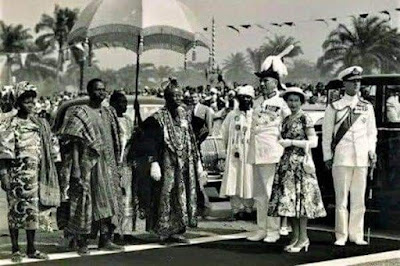
An important part of the history of Nigeria is her colonial story. Under colonialism and under the administration of Britain, the Queen (Queen Elizabeth) was the highest monarchical authority who was in control of government affairs. She carried out ceremonial functions in her position as head of state in the colonised Nigeria. She was also the monarch of the other common wealth realms, including the United Kingdom.
Even when Nigeria gained her independence in 1960, the Queen still held a high and important status in Nigeria. Queen Elizabeth was Queen of Nigeria from 1960-1963, the time between the nation’s independence and when she became a republic. You can see now the reasons her visits to Nigeria were always with such great fuss.
During her reign as head of state and Queen of Nigeria, Queen Elizabeth visited Nigeria twice.
The first time was in 1956, from the 28th of January to the 16th of February, 1956. At the airport, she was welcomed by federal dignitaries which included the Minister for Labour and Welfare at the time, Festus Okotie-Eboh and Governor-General Sir James Robertson. She was driven around in a Rolls Royce in the country’s capital, Lagos with lots of fun fare and royal services. She spent time in the Northern part of the country with the Sultan where she visited Kano and Kaduna. She also visited Jos and Enugu. The second time was when she attended the Common wealth Heads of Government meeting which was held between the 3rd to the 6th of December, 2003.
The 2003 Commonwealth Heads of Government Meeting was the eighteenth meeting of the Heads of Government of the Commonwealth of Nations. It was held in Abuja, Nigeria and hosted by the then President, Olusegun Obasanjo.
During the meeting, the Zimbabwean issue was dominant. This was the dispute over Zimbabwe’s suspension which led to another dispute over the re-election of Secretary-General Don McKinnon. Before the end of the meeting, Robert Mugabe’s announced that Zimbabwe was withdrawing from the Commonwealth.
This best explains the need for the presence of the Queen at the meeting. In a letter addressed towards the Nigerian President at the time, the Queen explained that her visit was a demonstration of the value Britain attached to its relations with Nigeria and recognition of the country’s role on the international stage. Queen Elizabeth opened the Commonwealth Heads of Government Meeting in Abuja on Friday, 5th December. Herself and the Duke of Edinburgh (often referred to as Her Majesty and His Royal Highness respectively) also attended other events during the Meeting.
During the Queen’s first visit in 1956, she went on a tour, known as the Queen’s 1956 Tour of Nigeria and the following incidents took place:
- Queen Arrives In Lagos (1956)
Queen Elizabeth and Prince Philip received welcome in the Nigerian capital, Lagos at the very start of the Royal tour.
- Inauguration Of New Federal Courts (1956)
The Queen attended the inauguration of the new federal courts in Nigeria.
- The Queen was at the Durbar also known as the Royal Durbar (1956)
At Kaduna, the then capital of Northern Nigeria, Queen attended a Royal Durbar
- Queen Elizabeth And Duke Philip Visited Jos – Tin Mines (1956)
Nigerian tribal canoes held a regatta for the Queen at Port Harcourt on the Ronny River after which she visited a Leper colony.
- Queen went on a tour in Enugu, Nigeria (1956)
When on the Royal tour, The Queen went on a visit to children’s rally and a tribal dancing at Enugu, Nigeria.
In Lagos, Queen Elizabeth attended a garden party and a formal session of the Federation Parliament.
- The life of Queen Elizabeth
Queen Elizabeth became queen following her father’s death in 1952. She was 25 years old at the time and became the queen regent of seven independent Commonwealth countries which were the United Kingdom, Canada, New Zealand, South Africa, Pakistan, and Ceylon (later renamed Sri Lanka). Many of the colonial realms, to include Nigeria gained independence during the course of her reign. As of the year, 2018, Queen Elizabeth II has been ruling England for 66years and is currently the longest-reigning British monarch in history.
- The role of Queen Elizabeth in colonial Nigeria
British influence in Nigeria began with the prohibition of the slave trade to British subjects in 1807. In 1861, Britain incorporated Lagos and in 1884, the Oil River Protectorate was established. It was at the Berlin’s conference of 1885 that other European powers acknowledged Britain’s dominance over the Niger area.
From 1886 to 1899, much of the Niger area was ruled by the Royal Niger Company, authorized by charter, and governed by George Taubman Goldie. On 1 January 1900, the Royal Niger Company transferred its territories to the British government for the sum of £865,000; the Southern Nigeria Protectorate and Northern Nigeria Protectorate were then passed from the Royal Niger Company to the Crown. The constitutions after the world war were progressive and allowed for increased representation and electoral government by Nigerians. The colonial period in Nigeria was precisely from 1900 to 1960, after which Nigeria gained its independence.
Queen Elizabeth II was Queen of Nigeria forms 1960- 1963: Nigeria was an independent constitutional monarchy. She was also the monarch of the other commonwealth nations such as the United Kingdom.
Nigeria became independent on 1 October 1960 by a British Act of Parliament. Nnamdi Azikiwe was installed as Governor-General of the federation and Tafawa Balewa continued to serve as head of a democratically elected parliamentary. The Queen was head of state in Nigeria, though her constitutional roles were mostly delegated to the Governor-General of Nigeria. The Governor-General represented the British monarch as head of state and was appointed by the Crown on the advice of the Nigerian prime minister in consultation with the premiers of the regions. The Governor-General was also responsible for appointing the prime minister and for choosing a candidate when there was no parliamentary majority. Other than this, the Governor-General’s office was essentially ceremonial.
The retention of the monarchy was not accepted by all and the political parties in Nigeria at the time agreed that the country should be a republic.
Nigeria adopted the President of Nigeria as head of state, on 1 October 1963 and hence, severed its relationship with the British monarchy.
Gossip House
Great work. Keep it up!!!!

Prince Harry and Meghan Markle bring warmth to Nigeria
I n early May Prince Harry and Meghan Markle, Duke and Duchess of Sussex, made a three-day visit to Nigeria. The couple are no strangers to the African continent – prior to his marriage, Prince Harry carried out much humanitarian work including the launch of Sentebale in Le- sotho, a charity that assists children orphaned by or living with HIV/AIDS. He joined a team of volunteers in Malawi to carry out elephant relocations. Meghan Markle had travelled to Rwanda for the clean water campaign as global ambassador for World Vision Canada. They last visited the African continent in 2019, for a Southern African tour of Malawi, Angola, South Africa and Botswana.
Since stepping back from the monarchy in 2020, Prince Harry and Meghan have continued engage- ments abroad from their home in California. Their visit to Nigeria was at the invitation of the country’s chief of defence staff, General Christopher Musa, who stressed that they were invited in a “personal, not official, capacity as the couple are no longer “working royals”.
The visit was planned in connection with Prince Harry’s role as founder and patron of the Invictus Games Foundation, which supports wounded, injured and sick servicepeople, both serving and veterans. Nigeria, which joined the Invictus “Community of Nations” in 2022, was the first African country to do so.
On the face of it, this visit by Prince Harry and Meghan Markle featured many of the hallmarks of a tried-and-tested royal tour, including visits to a school and a hospital, speeches, musicians showcas- ing local culture and an evening dinner reception. Over the 72 hours of the trip the Duke and Duchess met people from all walks of life, including schoolchildren, diplomats, and servicepeople.
Meghan’s ‘motherland’
Yet this was a unique visit by royals. The last royal tour of Nigeria was in 2003, by the then Prince of Wales and Duchess of Cornwall, now King Charles and Queen Camilla. Yet unlike her parents-in-law, Meghan Markle, who is the first biracial member of the British royal family, has a personal connection to Nigeria. In an episode of her podcast Archetypes in 2023, Meghan revealed that she is ethnically 43% Nigerian, based on a genealogy test she had taken, which led to her desire to further explore her Nige- rian roots. Indeed, as Meghan Markle stepped off the plane hand-in-hand with Prince Harry, she became the first member of the British royal family with an ancestral connection to Nigeria to visit the country.
Unlike most of the British royal family, Meghan Markle does not claim high-born ancestry. Her father is descended from Dutch, German, English and Irish immigrants to the United States. On her mother’s side, her American family were, only several genera- tions ago, indentured slaves in North Carolina, with, as she has now discovered, Nigerian origins. While co-hosting a Women in Leadership panel with Ngozi Okonjo-Iweala, director general of the World Trade Organization, Meghan described learning about her heritage as “eye-opening”, and called Nigeria “my country” and “my motherland,” and thanked the people of Nigeria for “welcoming [me] home.”
Unlike all the royal tours which have come before, Prince Harry and Meghan Markle’s visit to Nigeria was first and foremost rooted in themselves, rather than an institution they represent, making it perhaps the most sincere and heartfelt of all royal tours on the continent to date – of which there have been many.
The British royal family has a long and complicat- ed relationship with the African continent stretching back centuries, which is firmly entwined with Brit- ain’s history of colonial rule in many African nations.
Royals’ complex Africa history
The first official tour by a member of the British royal family to the continent was in 1860, when Prince Alfred, son of Queen Victoria, visited South Africa on HMS Euryalus. It was during his mother’s reign that the European “scramble for Africa” grew in earnest.
It saw European nations colonise many African countries, some of whom would not gain independ- ence until close to the next millennium. In 1928, King Edward VIII undertook an “official Imperial tour” to East Africa, which saw him shoot what was then known as the “big five” – a lion, an elephant, a rhino, a leopard and a buffalo.
Towards the middle of the century sub-Saharan African countries began to throw off colonial rule, starting with Ghana, which gained independence from Britain in 1957.
The late Queen Elizabeth II was staying in Kenya when she was told that her father had died and that she was now Queen. Over the course of her reign she visited the African continent 21 times, and oversaw the independence process for many former British colonies.
Her first visit to Nigeria was in 1956, four years before its independence, and she received a pledge of loyalty upon arrival on behalf of her then Nige- rian subjects. In a marked contrast, her second visit in 2003 was to attend the Commonwealth Heads of Government Meeting, Nigeria having joined as a member in 1960.
Several royal visits to Nigeria followed over the years, including a tour by the former Prince and Prin- cess of Wales in 1990, but Prince Harry and Meghan’s recent visit to the West African country strikes a completely different tone – that of authenticity. A widely-derided Jamaican tour in 2022 by Prince William and Kate Middleton saw the failed optics of Jamaicans cheering the royals from behind fences and led to accusations of colonial-style arrogance. In contrast, Prince Harry and Meghan Markle struck all the right notes in Nigeria.
Human touches
From Harry donning a Nigerian scarf and joining in a game of volleyball, to Meghan – who, after being presented with a bouquet of roses by a young girl, offered her one of the roses to keep as a memento – the trip was peppered with human touches. Their itinerary was packed with promotion for causes dear to their hearts, including mental health, women’s empowerment and sports; and their enthusiasm was clear to see.
The visit was lauded in the Nigerian press as a success, with Punch describing Kaduna State governor, Senator Uba Sani, as “delighted to receive Harry”, and Vanguard stating that “Harry and Meghan’s visit to Nigeria carried a lot of symbolisms which must not be lost”, describing the couple’s visit as “a true reflection of the populist activities of [Harry’s] late mother, Princess Diana, fondly known as the ‘Queen of Hearts’.”
After their return to America, the couple posted on their social media, thanking “the Nigerian com- munity for their tremendous hospitality” and said they hoped it would be the first of many memorable trips to the country, as they continue to carve out their own unique role outside the royal family. n

IMAGES
COMMENTS
During her reign as head of state and Queen of Nigeria, Queen Elizabeth visited Nigeria twice. The first time was in 1956, from the 28 th of January to the 16 th of February, 1956. At the airport, she was welcomed by federal dignitaries which included the Minister for Labour and Welfare at the time, Festus Okotie-Eboh and Governor-General Sir James Robertson.
A very historic visit to Lagos Nigeria in 1956 by Her Majesty Queen Elizabeth II, she was warmly received and given a very special Royal reception by Nigeria...
There is approximately a time frame of 53 years between both visits to Nigeria by the monarch. Queen Elizabeth's 1st visit: 28 January - 16 February 1956. About three years after she was coronated as the monarch of England (1953), Queen Elizabeth toured parts of the British empire and the commonwealth, a feat her predecessors never achieved.
Footage of the Queen's visit to Nigeria in 1956. The Queen of England, Queen Elizabeth II, visited Nigeria for the first time on the 28th of January, 1956, four years to Nigeria's independence and stayed for 20 days. She was received with a military parade at the Ikeja Airport in Lagos and welcomed by dignitaries such as the then Governor-General, Sir James Robertson, his wife, the ...
January-February 1956.Footage of excerpts of the visit of Queen Elizabeth II of Britain to the British colony of Nigeria between 28 January-16 February 1956...
February 1956.Footage of the tour of Queen Elizabeth II, the British monarch to the then colony of Nigeria which was preparing for independence.Moments captu...
In 1956, Queen Elizabeth II was welcomed to Lagos, Nigeria by a large crowd. That was four years before Nigeria's independence. The queen's visit was received with lots of fanfare. Among those who came to receive her was the influential Federal Minister of Labour and Welfare, Chief Festus Okotie Eboh. She was also received by Lagos ...
The Queen and the Duke of Edinburgh visited the City of Kano before ending their tour and leaving for London. The Queen and the Duke ride in an open-topped limouisine car watched by a large crowd lining both sides of the road. ... A Visit to kano. [Royal Tour of Nigeria, 1956] c.1956. 19.9 x 25.0 cm ...
As queen, one of her ceremonial duties included visiting the British colonies, to which Nigeria belonged. She visited Nigeria twice—in 1956 when Nigeria was a British colony and in 2003 when Nigeria was already a sovereign nation. First Visit. Queen Elizabeth's visit to Nigeria in 1956 happened three years after ascending the British throne.
The year was 1956, and there was much fanfare and anticipation for Queen Elizabeth's first visit to Nigeria.. The young monarch was just a few years into her reign and making a highly ...
In 1956, Queen Elizabeth the II visited Nigeria, where she commissioned her bronze sculpture which was exhibited by Ben Enwonwu, a Nigerian sculptor. The queen sat for Enwonwu in London for the art work which portrays her seated with her hands in her laps in 1957 and was intended to mark her visit to Nigeria in January and February 1956.
Queen Elizabeth II in Nigeria, 1956 Feb 1956. Gelatin silver print | 16.0 x 21.4 cm ... Photograph of Queen Elizabeth II pictured seated at her desk during her farewell broadcast from Government House in Nigeria following her visit to the country. People involved . Subject(s) Search the collection View the person page Queen Elizabeth II, Queen ...
In 1956, Queen Elizabeth and Prince Phillip undertook a royal tour of Nigeria. Mirrorpix // Getty Images On their trip, they went to Lagos, Calabar, Enugu, Jos, Kaduna, Kano, and Port Harcourt.
The Queen posing with the New Zealand Cabinet during her visit to New Zealand, 1981. The Queen surrounded by children in Queen Street Mall, Brisbane City, 1982. The Queen and the Duke of Edinburgh at the Closing Ceremony of the XII Commonwealth Games, Brisbane, 1982. The Queen opening World Expo 88 at Brisbane, 30 April 1988.
Queen Elizabeth II's first visit to Nigeria in 1956. She was welcomed at the airport by federal dignitaries including the then Minister for Labour and Welfar...
She came to Nigeria for the first time in 1956 as part of her royal tour to Commonwealth countries, from January 28 to February 16. The Queen in Nigeria in 1956 [Pinterest] Pulse Nigeria Her ...
In 1956 during her Official visit to Nigeria, the Queen of England; Queen Elizabeth II was scheduled to visit only Ibadan, Enugu and Kaduna as the regional capitals. *Chief Odutola, the Ogbeni Oja of Yorubaland welcoming the monarch to his home.
Statue of Elizabeth II, Lagos. A bronze sculpture of Elizabeth II by the Nigerian sculptor Ben Enwonwu was commissioned by the Queen on her visit to Nigeria in 1956, and she sat for Enwonwu in London in 1957. It was completed by Enwonwu in London and exhibited by him at the Royal Society of British Artists exhibition in London in November 1957.
- Queen went on a tour in Enugu, Nigeria (1956) When on the Royal tour, The Queen went on a visit to children's rally and a tribal dancing at Enugu, Nigeria. In Lagos, Queen Elizabeth attended a garden party and a formal session of the Federation Parliament. - The life of Queen Elizabeth. Queen Elizabeth became queen following her father's ...
Meghan's 'motherland' Yet this was a unique visit by royals. The last royal tour of Nigeria was in 2003, by the then Prince of Wales and Duchess of Cornwall, now King Charles and Queen Camilla.
Queen Elizabeth II visit to Lagos Nigeria in 1956, three years after ascending the throne. #Queen #LASG #LagosNigeria